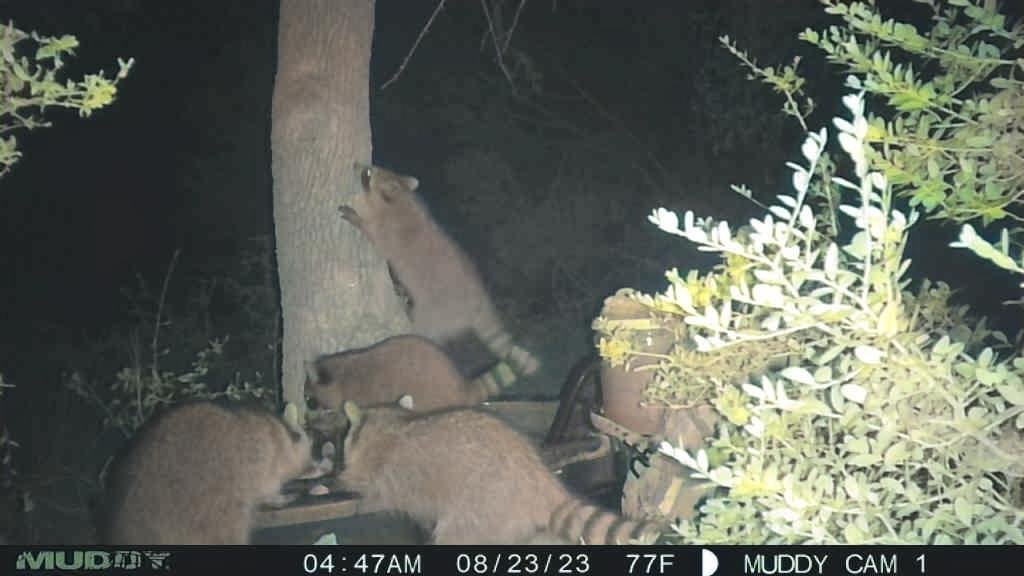The Irritable Back
Erethizon dorsatum—the irritable back—aka the North American Porcupine
Photo: Bob Currie
Constance Quigley
Trail cameras are great for conducting a property census for wildlife management, which is one of our activities to qualify for agricultural valuation on our small acreage. We use MUDDY cameras that are equipped with cell phone functionality, so the cameras send me photos every morning.
We recently added a second trail camera to monitor nocturnal activities at our apiary pond. The first camera at our watering station has captured so much wildlife that I wanted to see what else might be visiting a bit farther away. We’ve seen everything from song birds, screech owls, armadillos, foxes, and possums to a bobcat and coyote. And of course raccoons. Nothing visits a water station more than a gaze of raccoons, and they party hard. Believe me. There are diving contests and judges with numbered cards. Here is a recent photo of the four raccoons that frequent our water stations.
After placing the new camera, one of the first photos I received was of a North American porcupine climbing (or descending) the tree next to the pond. Porcupines actually descend tail first, so it could be either action here. It looks like a Dr. Seuss character, doesn’t it?
Below is the first of several similar photos I have received. It is almost a nightly occurrence to catch the porcupine in this position. I’ve studied the canopy of this live oak tree many times since but have never seen our friend in the branches. The tree lost a lot of its limbs to the 2023 ice storm, and I suspect Porky likes to eat the new leaves and growth emerging from those damaged areas.
Around the same time we placed the new trail camera, I found scat on the deck of the apiary shed next to the pond. A little research led me to identify it as porcupine scat. Only a fellow naturalist would find that exciting, but read on if you’re as thrilled as I was.
A day later I received a photo of our now-named Porky getting a drink from the pond. And just a couple of nights ago, he was sitting on the edge. I’m so happy to have a regular visitor!
I have encountered this porcupine in person a couple of times. Porky likes to sit next to the apiary shed and watch the sunrise, so I’ve seen the unmistakable silhouette in my early morning visits to check the pond. Porky usually ambles under the shed when I approach, as I speak quietly to notify any visitors of my arrival. (Does often bring their fawns here for a drink, and there is a large bird feeder a few feet from the pond.) One time Porky was actually sitting on the apiary deck facing me as I turned to leave. We both acted nonchalant, so there was no confrontation. But I wish I’d taken my phone or camera with me!
My photos are all taken during the night and cannot do justice to the beauty of the porcupine, so I enlisted the aid of Bob Currie, who happened to have a great video and some color stills of a porcupine from several years ago. These are shown below.
Video: Bob Currie
Photo: Bob Currie
Just a few neat facts
Baby porcupines are called porcupettes
A group of porcupines is called a prickle
Food includes leaves, twigs, bark, and the occasional insect or lizard
3rd largest rodent in the Americas, after the capybara and the North American beaver
Mating season is October/November. Females are only fertile for a few hours. Porcupines only produce 1-3 offspring each year with a 7-month gestation period - very unusual for a rodent
Has approximately 30,000 quills, which are modified hollow hairs and constantly replenish like hair. The hollow nature of the quills allow porcupines to swim easily, as they can float!
Porcupines are nocturnal and solitary, except when mating
Tree climbers that can be clumsy: they sometimes fall and injure themselves with their own quills
Quills contain antibiotic properties but can also be deadly to predators as they can move through muscle to vital organs
Will run backwards if attacked in order to skewer the attacker with their quills
Make lots of noises, “muttering” while they waddle and are particularly loud when mating
They crave salt due to their diet
Photo: Bob Currie
Based on the information I’ve gathered, we will be adding a salt/mineral block near the apiary pond, which will benefit Porky as well as the deer, and I’ll definitely be listening for strange calls and noises around mating season in October/November. Maybe I’ll have an update at that time!
I’ve had a lot of fun reading and writing about our rodent friends. The following articles have some more interesting facts and information if you would like to learn more about the North American porcupine.







